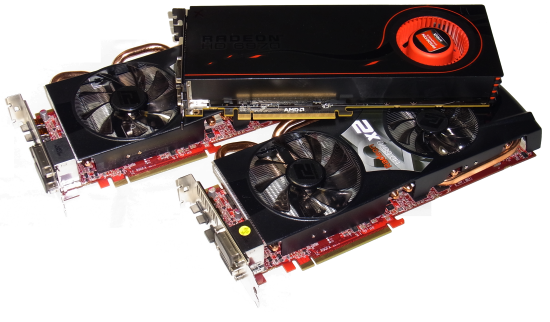Micro-Stuttering And GPU Scaling In CrossFire And SLI
We've received many emails from readers asking about the phenomenon known as micro-stuttering and what it means to multi-GPU setups in CrossFire and SLI. After running plenty of benchmarks, we're ready to weigh in on what turns out to be a real issue.
Step 2: CrossFire With Three GPUs
One Radeon HD 6870 X2 and One Radeon HD 6870 Give Us Three-Way CrossFire
Using PowerColor's Radeon HD 6870 X2 lets us bridge three Barts GPUs, despite only having a single bridge connector to tack on a Radeon HD 6870 card. Can three mid-ranged hearts beat in unison?
The total price of these test cards add up to about $650. That's still $80 less than a GeForce GTX 590 though. Unfortunately, all of AMD's Radeon HD 6990s have seemingly been deactivated from Newegg, Zipzoomfly, and TigerDirect, so there's really no valid comparison there.
But after looking at the graphs, the lack of 6990s is hardly what perplexes us.
We repeated this same test using a number of games yielding different average frame rates. So long as the average is above 30 FPS, the resulting output is almost stutter-free. Minor differences in when frames hit the screen are not apparent, and so they don't bother us at all. The experience is similar to using a single GPU.
After analyzing the dual-card configuration, this is certainly not what we were expecting.
Interim Assessment
Get Tom's Hardware's best news and in-depth reviews, straight to your inbox.
Amazingly, the three-way setup has a tremendous advantage over two cards in CrossFire. Additionally, it costs less than the dual-GPU GeForce GTX 590 and Radeon HD 6990 cards, too. Of course, the average frame rate only really increased about 20% compared to a Radeon HD 6870 X2, and 420 W worth of power draw is no small figure. It'd take an overclocked Radeon HD 6990 to top that.
Current page: Step 2: CrossFire With Three GPUs
Prev Page Step 1: CrossFire With Two GPUs (Vs. SLI) Next Page Step 3: CrossFire With Four GPUs (Vs. SLI)
Igor Wallossek wrote a wide variety of hardware articles for Tom's Hardware, with a strong focus on technical analysis and in-depth reviews. His contributions have spanned a broad spectrum of PC components, including GPUs, CPUs, workstations, and PC builds. His insightful articles provide readers with detailed knowledge to make informed decisions in the ever-evolving tech landscape
-
thorkle This is a very interesting article, I have wondered about this issue myself many times in the past. I was always curious why I would see strange lag like anomalies while still achieving perfect frame rate. Bravo TomsReply -
compton Well, I'm a little surprised that three cards in Crossfire seem to eliminate visible microstuttering -- I would have guessed that triple cards would increase stuttering. But it also seems like there must be other factors at work. Unfortunately, there really isn't a good way to test for other factor -- if you even could know what to test for. In some circumstances, it seems like my monitor is causing some issues. If I play a game (lets use Fallout New Vegas for example) at a Synced 60FPS, you can look at FPS and it never deviates. It only uses 1/3 of my GPU cycles. But on one monitor, at the same resolution, it micro stutters. On another monitor, it looks perfectly fine. I thought it was some lag variance -- but then I've been told lag is always constant, that the reason lag varies in monitor testing is improper test methods. What ever the reason, it's actually really annoying. And I'm not anything approaching a competitive FPS player. Thanks for helping to track this issue down.Reply
-
iam2thecrowe so will you now change your best gpu for the money from 2 x 6850's, since they obviously suck. I already bought one 6850 thinking it would be great to crossfire later and that was the best choice according to you toms........now i will have to throw it in the bin come upgrade time and buy a better single card. Oh, and AMD/Nvidia, if you cant get dual card configs to work properly, don't offer them, your wasting our money. Please fix this microstuttering crap, im sure it would be possible with a driver tweak.Reply -
bombat1994 i think the MSI Radeon 6870 Hawk is the best graphics card on the market right now in terms of heat, power, performance and priceReply -
tmk221 in most games you can limit maximum frame rates. So maybe if you limit max FR to let say 10 to 15 above min FR then the Micro-Stuttering effect would be gone ? anyone tried this? please shareReply -
shoelessinsight What is performance like using other load-balancing methods, like the split frame rendering that SLI originally used, or ATI's Scissor mode? Are these modes still available to those that choose them?Reply
Obviously, they won't reach frame rates as high as those attained through AFR, but if the frame rate loss is small enough, those modes might still be justifiable if they eliminate micro-stuttering altogether.
I'd be curious if these alternate methods could justify the cost of an additional card through added performance without coming with the drawback of micro-stuttering. -
boletus Regarding the decreased stuttering with 3 or 4 cards: could this be a similar effect to superimposing sine waves? Two waves a half cycle apart show visible peaks and valleys, while three waves at evenly staggered cycles form a much smoother band (on a graph or a scope).Reply -
haplo602 I ma confused ... you are using 2 identical cards, so the frame rendering times as show on the metro 2033 second would be THE SAME on a single card as on a dual card configuration. the only difference is when each card starts to render right ?Reply

